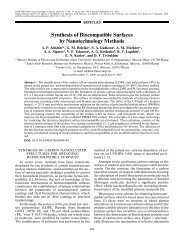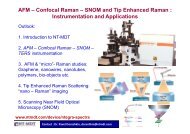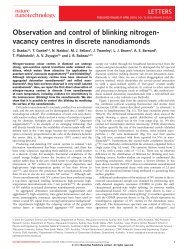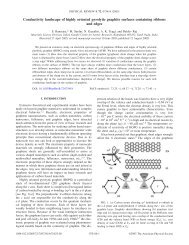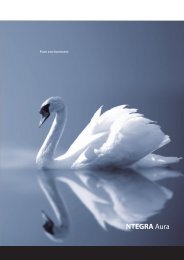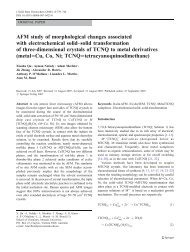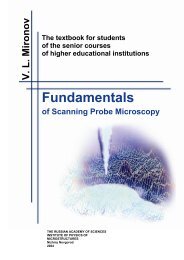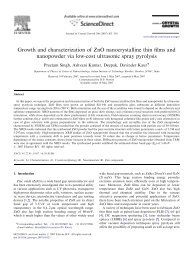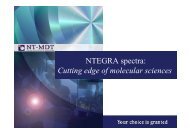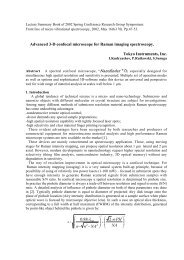A New Scanning Method for Fast Atomic Force Microscopy - NT-MDT
A New Scanning Method for Fast Atomic Force Microscopy - NT-MDT
A New Scanning Method for Fast Atomic Force Microscopy - NT-MDT
You also want an ePaper? Increase the reach of your titles
YUMPU automatically turns print PDFs into web optimized ePapers that Google loves.
This article has been accepted <strong>for</strong> publication in a future issue of this journal, but has not been fully edited. Content may change prior to final publication.8Magnitude (dB)Phase (deg)4020020050100150200(a)10 1 10 2 10 310 1 10 2 10 3f (Hz)4020020050100150200(b)10 1 10 2 10 310 1 10 2 10 3f (Hz)Figure 9. Experimental (−−) and identified model (—) frequency responseof (a) G cxux (s) and (b) G cyuy (s).resonances in x and y axes. In the x-axis the resonance isat 576 Hz with a damping ratio of 0.004 and in the y-axisthe resonance is at 578 Hz with a damping ratio of 0.008. Itmust be mentioned here that the non-minimum phase zerosin both transfer functions do not reflect the physical nature ofthe scanner, but are rather artifacts of the system identification.The subspace-based system identification approach introducesthese non-minimum phase zeros in order to model delayswhich exist in the system due to the capacitive sensor signalprocessing electronics and dSPACE sampling time.V. CO<strong>NT</strong>ROLLER DESIG<strong>NT</strong>his section addresses design of feedback controllers undertakenin this work. Feedback controllers <strong>for</strong> the x and yaxes were designed independently since the scanner is treatedas a two SISO systems in parallel. The key objectives of thecontroller design are to achieve good damping ratio <strong>for</strong> the firstresonant mode of the piezoelectric tube scanner and to achievea high closed-loop bandwidth to allow accurate tracking of theCAV and CLV spirals. Although the use of CAV spiral allowsus to select the frequencies that will not excite the resonanceof the scanner, it is still important to actively damp the scanner.External vibration and noise can result in perturbations in theAFM image if scanner’s mechanical resonance is not damped.The need to damp the scanner becomes more important whenit is used to track a CLV spiral input. This is because theCLV spiral input consists of high frequency components thatwill inevitably excite the mechanical resonance of the scanner.Additionally, the feedback controller can minimize the effectof piezoelectric creep, that can cause further perturbation inthe image [30].Structure of the x-axis feedback controller is illustrated inFig. 10. A similar controller was designed <strong>for</strong> the y-axis. Theoverall control structure consists of an inner and an outerloop. The inner loop contains a Positive Position Feedback(PPF) controller that works to increase the overall damping ofthe scanner. The outer loop contains a high-gain integral conrxux cxI(s)TubeKPPFxFigure 10. Structure of the x-axis feedback controller. The inner feedbackloop is a positive position feedback (PPF) controller designed to damp thehighly resonant mode of the tube. Integral action is also incorporated toachieve satisfactory tracking.troller to provide tracking. The PPF controllers were initiallydesigned to suppress mechanical vibrations of highly resonantaerospace structures [31]. They have been successfullyimplemented on a range of lightly damped structures [32]–[34]. Their effectiveness in improving accuracy and bandwidthof nanopositioning systems was recently investigated in [15],and their important stability properties were established in[35]. PPF controllers have a number of important features.In particular, they have a simple structure which makes theirimplementation straight <strong>for</strong>ward and their transfer functionsroll off at a rate of 40 dB/decade at higher frequencies. Thelatter is important in terms of the overall effect of sensornoise on the scanner’s positioning accuracy. The details of theprocedure that was followed to design these PPF controllersis documented in reference [15]. The obtained PPF controllerscan be described asandK PPFx (s) =K PPFy (s) =9.282 × 10 6s 2 + 6062s+2.736 × 10 7 (41)9.313 × 10 6s 2 + 6071s+2.758 × 10 7 . (42)The designed control system also includes a high-gainintegral controllerI(s) = K I(43)sas illustrated in Fig. 10. Inclusion of an integrator amountsto applying a high gain at low frequencies that reduces theeffects of thermal drift, piezoelectric creep and hysteresisto a minimum. Another important benefit of the proposedcombined feedback structure is the significant reduction thatcan be achieved in cross-coupling between various axes of thescanner.The use of high gain in the integral controllers is madepossible by the suppression of the sharp resonant peaks in the xand y axes due to the PPF controllers. Fig. 11 illustrates Bodediagrams showing gain margins when a unity gain integralcontroller is cascaded with undamped scanner’s transfer functions,1) G cx u x(s) and 2) G cy u y(s), and with damped scanner’stransfer functions 3) T cx u x(s) and 4) T cy u y(s), whereandT cx u x(s) =T cy u y(s) =G cx u x(s)1 − K PPFx (s)G cx u x(s)(44)G cy u y(s)1 − K PPFy (s)G cy u y(s) . (45)Copyright (c) 2009 IEEE. Personal use is permitted. For any other purposes, Permission must be obtained from the IEEE by emailing pubs-permissions@ieee.org.Authorized licensed use limited to: University of <strong>New</strong>castle. Downloaded on November 26, 2009 at 00:02 from IEEE Xplore. Restrictions apply.



